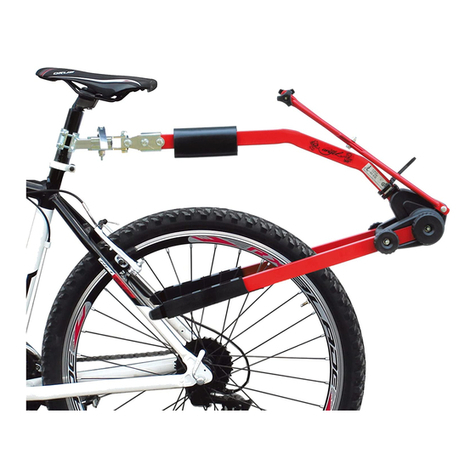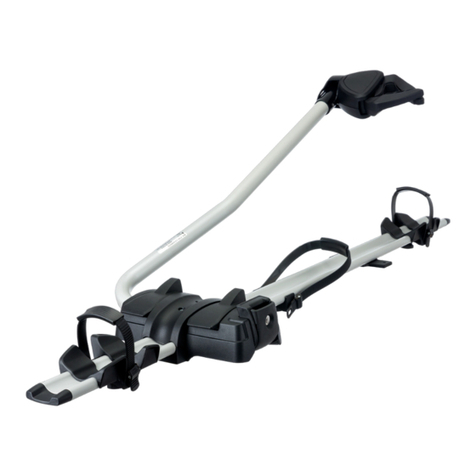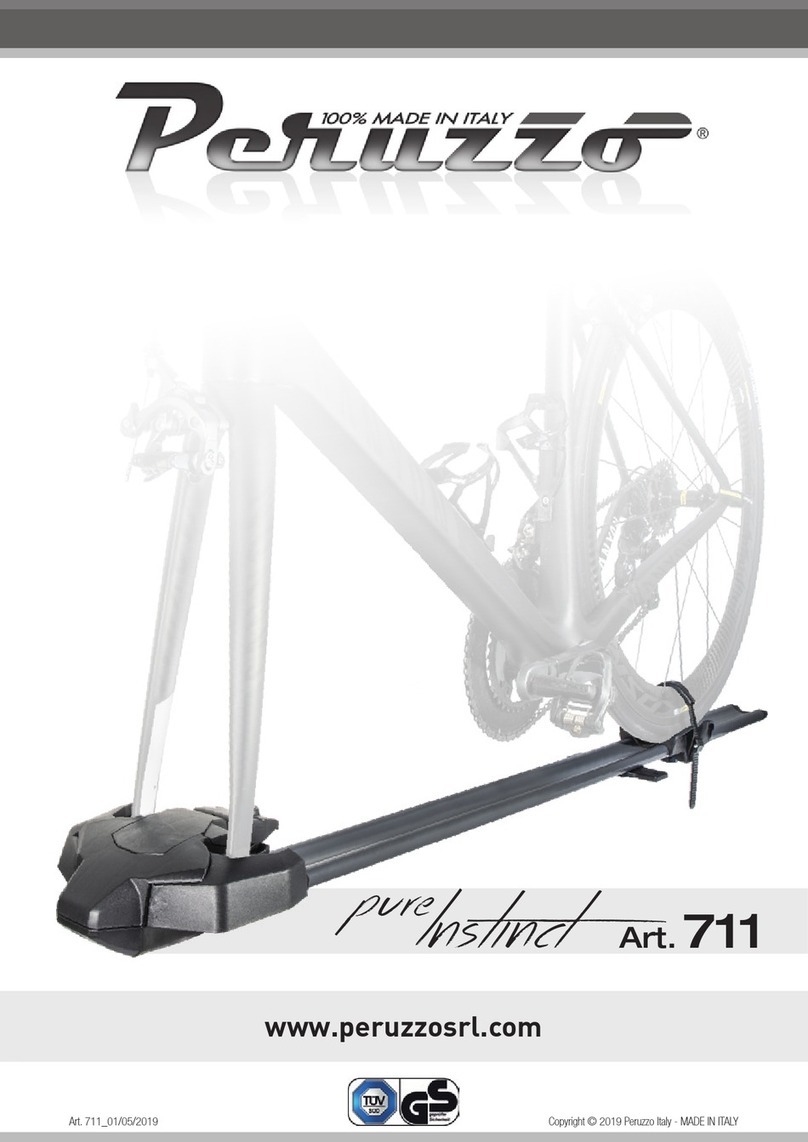
707_PARMA E-BIKE_18/09/18 9/32 Copyright © 2012 Peruzzo Italy - MADE IN ITALY
EN
ASSEMBLY AND USER INSTRUCTIONS
Whenever this product is used the following information must be
taken into consideration: the bike rack is a safe product if used
correctly, but if it is used incorrectly it can cause damages to you
and to anyone driving behind you.
1) Insert the plugs 1in the square bearing tubes 2(Fig. A).
2) Insert the plugs 3in the tilt device tube 4(Fig. A) and in the bike xing
arch 5(Fig. F2).
3) Attach the hook 6to the tilt device 7(Fig. A).
4) Mounting the aluminium tyre cradles 8: carry out the preliminary
operations as per the instructions B1-B2-B3(Fig. B), attach the
cradles to the square bearing tubes 2with interposed shims 9, then x
them with the washers and nuts 10 (Fig. B).
5) Mount the rear lights 11 to the lighting board 12 and x together with
the washers and nuts 13 (Fig. C); take care not to damage the wires and
not to over-tighten the nuts as this could damage the plastic parts.
Thread the 13 pin plug through the central hole of the lighting board 12.
6) Fix the number plate frame 14 to the light bar 12 with the screws 15.
7) Fix the lighting board assembly 12 to the square tube 16 with the
screws 17, the nuts and the washers 18; make sure you thread the tilt
hook 6into the slot provided (Fig. D).
8) Mounting the bike loader rail 19: carry out the preliminary operations as
per the instructions E1-E2 (Fig. E), then mount it on the lighting board
12 and x with the knobs 20 (Fig. E).
9) Mounting the bike xing arch 5:
- Undo and remove the knobs 21 and the washers 22 from both sides
(Fig. F1);
-Placethebikexingarch5inthehalf pipe ofthetilt adjustment
element 23, then x it with the washers 22 and the knobs 21 (Fig. F2).
For personal safety and to avoid damaging the vehicle we recommend 2
people mount the bike rack.
10) Push the lever 24 upwards, to disengage it turn the wrench 25 counter
clockwise (Fig. G1).
11) Place the xing block 27 on the towball 26 (Fig. G2).
12) Close the clamping device by lowering the lever 24: at least 45 kg.
clamping force is required. (Fig. G2).
Adjustment of closing hand force
It is always necessary to make the rst adjustment when the product is
purchased. Then, every time the product is used, the clamping force must
be checked and adjusted if necessary. In order to prevent accidents and
damageit is advisableto ask asecondperson toassistyouin this
procedure as well. After disengaging and lifting the lever 24 the second
person must hold the cycle carrier in a horizontal position. The screw 28
must be adjusted with the wrench provided 29 so that the clamping
force on the lever is increased to a minimum of 45 Kg. (Fig. G2). Make
sure that the bike rack does not rotate when the clamping device has
been locked.
HOW TO INSTALL THE BIKE CARRIER ON
THE TOWBALL
13) Use the rail 19 to facilitate loading the bike: to attach it to the aluminium
tyre cradle 8follow instructions H1-H2 (Fig. H).
POSITIONING AND FIXING THE BIKES ON
THE BIKE RACK
BIKE RACK INCLINATION
(Fig. L/M/N)
To tilt the bike rack hold it up with one hand while you pull the hook 6
with the other (Fig. L). To avoid injury or damage, this operation of
tilting the bike rack should be carried out with the help of a third person.
To close the bikerack, lift it until the tilt mechanism 7engages
completely by passing from the tilt position (Fig. M) to the closed
position (Fig. N).
14) Position the biggest, heaviest bike near the car, place the wheels on
the aluminium cradle 8and lean it against the xing arch 5. Fasten
the bike to the xing arch 5with the arm 30(Fig. I2). Fasten the
wheels with the xing straps 31 (Fig. I1).
15) Repeat operations 14) for the second bike.
IMPORTANT
: For safe transportation of the load the bike carrier is
supplied with a strap 32 for tying all the bikes to the xing arch 5.
Check that the belt is mounted correctly by pulling on it.
As well as the information described below please observe the
"
Conditions, suggestions and limits for use
" specied in the EC
type test certicate.
- Weight and maximum capacity of "PARMA E-BIKE" bike racks:
* Model 707 (17,00 kg.) ---> 2 bikes, max. capacity 60 kg.
- Never exceed the permitted capacity of the towing hook installed. The
combined weight of the bike rack and the load must never exceed the
permitted capacity. Keep the towing hook ball surface clean from dirt
and oil.
-The driver is always responsible for the load he is transporting and
consequently he is also responsible for checking the fastenings both
before starting the trip and at regular intervals during the trip.
- Check the car manual for the specications concerning the maximum
permissible rear axle weight.
- Verify compliance with the value D(maximum load bearing capacity)
of the towball specied by the car or towball manufacturer; the value
D for the towball must be at least (760 Kg) 7.6kN; older towballs
often only specify the permissible load on the towball GAand the
total permissible load of the towing vehicle GKrather than value D; in
this case the value Dcan be calculated using the values specied in
the vehicle maintenance or registration booklet:
- Remove from the transported bikes children's seats, transport
baskets, rain covers or other elements that could get lost or increase
the air resistance.
- Do not carry more bikes than the number indicated for a specic
model.
- Bike parts, such as for example the handlebars or pedals, must not be
left in the normal position of use; they must be folded to avoid
dangerous projections.
- Ensure that the bike rack is tted correctly on the towing hook and
that the bikes are secured as instructed.
- The bike rack is only suitable for transporting bicycles.
ATTENTION – SAFETY REQUIREMENTS
D = x
9,81 (GA xGK)
1000 (GA +GK)
(D in [kN] / GAin [kg] / GKin [kg])































